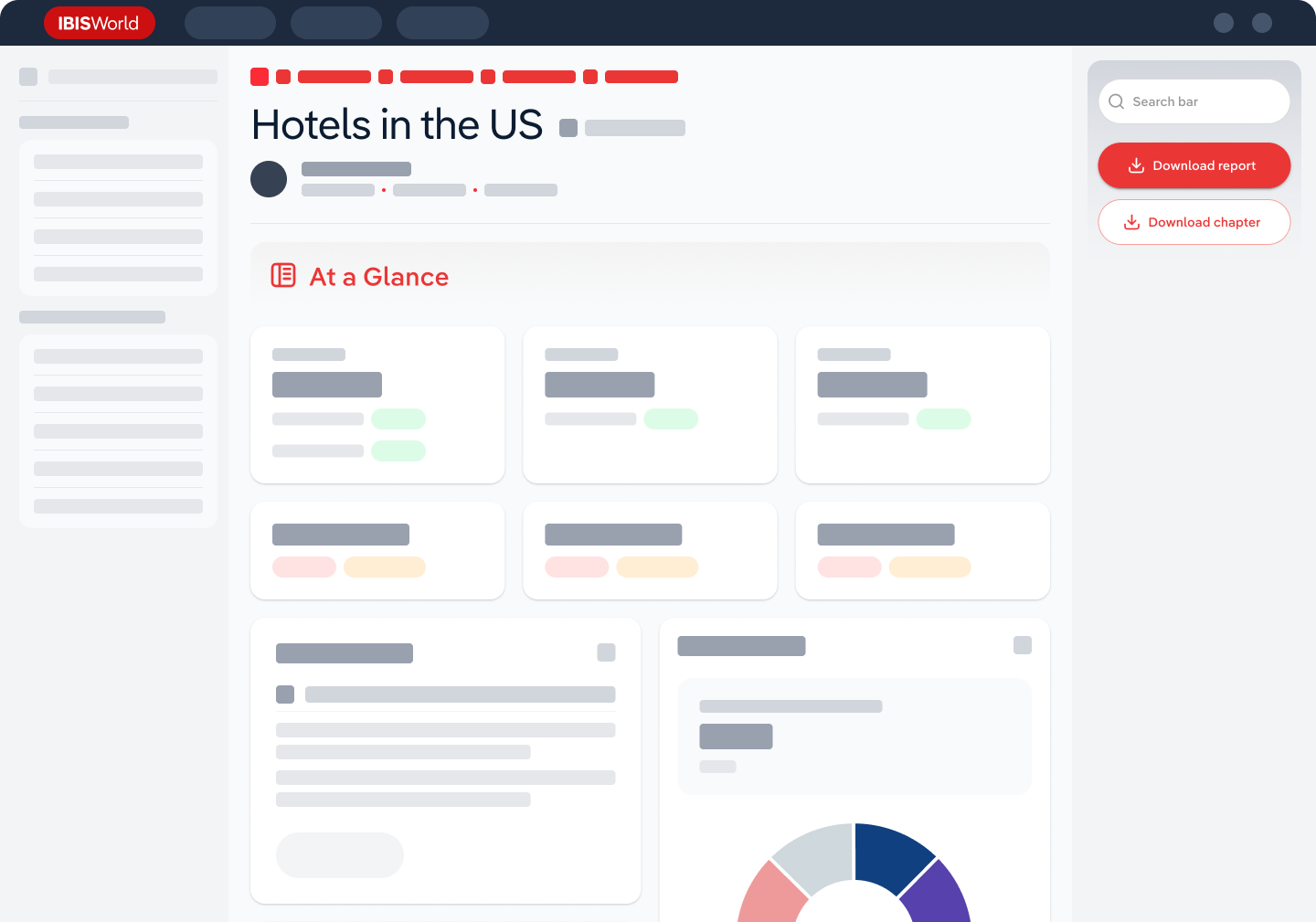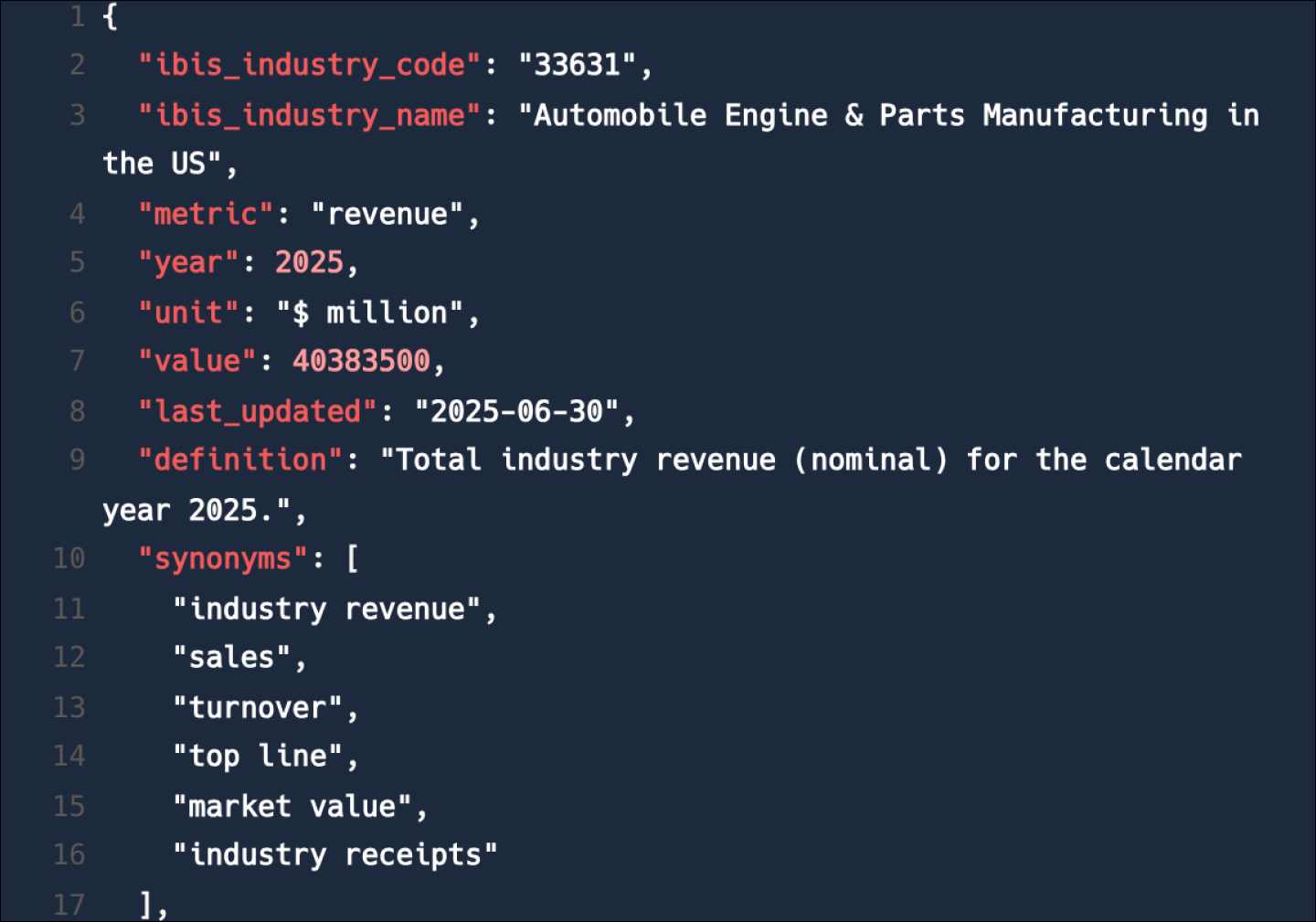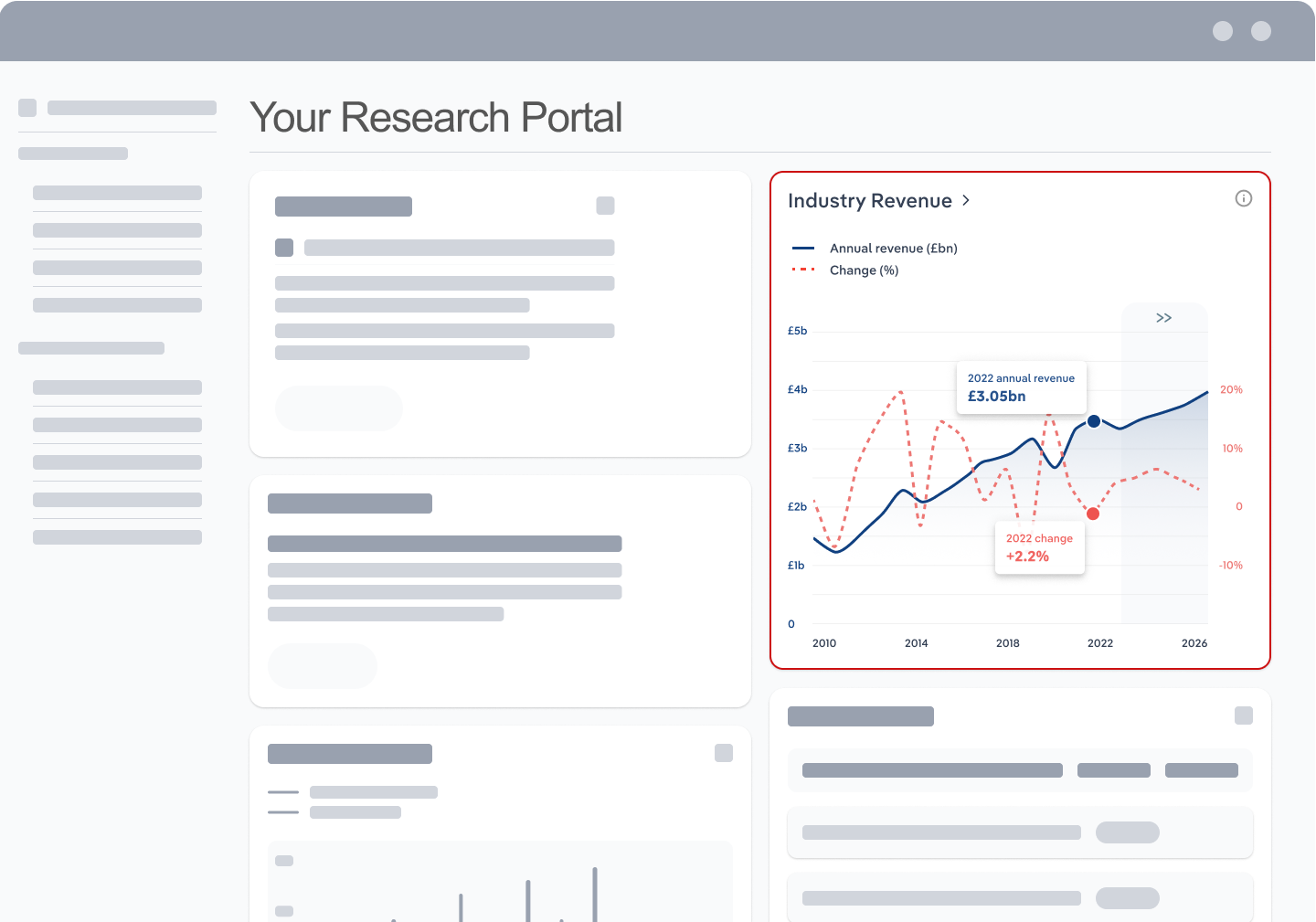Industry Statistics and Trends
Market size and recent performance (2015-2030)
Industry revenue has declined at a CAGR of 0.4 % over the past five years, to reach an estimated $129.3bn in 2025.
Trends and Insights
Wholesalers struggle as retailers cut inventory amid consumer confidence fluctuations
- Consumer confidence saw a staggering drop of 21.1% in 2020, which has had lasting effects on the clothing wholesale industry. Although the inhibit in 2024 was just 1.6%, the lack of stability in confidence levels continues to cause concern among stakeholders. Retailers have responded to this uncertainty by reducing their inventory orders, directly impacting wholesalers who rely on consistent purchases.
- Additional trends and insights available with purchase
Industry outlook (2025-2030)
Market size is projected to grow over the next five years.
Trends and Insights
Freight index climb will enhance shipping efficiency and reliability, benefiting wholesalers' inventory management
- The 1.4% climb in the freight transportation services index in 2025 will lead to improved freight capacity and efficiency, meaning wholesalers will face more reliable and timely shipments. This will reduce inventory holding costs and stockout risks, allowing wholesalers to respond faster to retailer demand and avoid lost sales.
Biggest companies in the Clothing & Clothing Accessories Wholesaling in the US
| Company | Market Share (%)
2025 | Revenue
2025 | Profit
2025 | Profit Margin (%)
2025 |
|---|
There are no companies that hold a market share exceeding 5% in the Clothing & Clothing Accessories Wholesaling in the US industry.
Products & Services Segmentation
Industry revenue is measured across several distinct product and services lines, including Men's shirts, sweaters, slacks and jeans, Women's outerwear including skirts, slacks and jeans and Womens dresses, blouses and sweaters, including unisex clothing. Men's shirts, sweaters, slacks and jeans is the largest segment of the Clothing & Clothing Accessories Wholesaling in the US.
Trends and Insights
Business-casual trends elevate men's shirts, sweaters, slacks and jeans in modern workplaces
- Men's shirts, sweaters, slacks and jeans form a versatile collection of formal and casual apparel. Steady demand across various settings supports consistent sales throughout the year. Their adaptability makes them essential in men's wardrobes, catering to diverse style needs for professional and everyday occasions.
- More insights available in the full report
Table of Contents
About this industry
Industry definition
The Clothing and Clothing Accessories Wholesale industry encompasses merchant wholesalers that distribute apparel and accessories. This industry is a crucial intermediary between manufacturers and retailers, playing a vital role in the fashion supply chain infrastructure.
What's included in this industry?
Products and services covered in the Clothing & Clothing Accessories Wholesaling industry in the United States include Wholesaling men’s shirts, sweaters, slacks and jeans, Wholesaling women's dresses, blouses and sweaters, including unisex clothing, Wholesaling women's outerwear including skirts, slacks and jeans, Wholesaling underwear and sleepwear, Wholesaling men's suits, coats and formal wear and Wholesaling children's and infants' apparel.Companies
Companies covered in the Clothing & Clothing Accessories Wholesaling industry in the United States include .Purchase this report to view all major companies in this industry.
Related Terms
Related terms covered in the Clothing & Clothing Accessories Wholesaling industry in the United States include the american apparel & footwear association (aafa), extensible markup language (xml), radio-frequency identification (rfid) and fast fashion.Industry Code
NAICS 424320 - Clothing & Clothing Accessories Wholesaling in the US
Performance
Get an indication of the industry's health through historical, current and forward-looking trends in the performance indicators that make or break businesses.
Analyst insights
Retailers reduce inventory orders amid consumer confidence fluctuations. This has created significant challenges for wholesalers, as ongoing instability in confidence levels ...
In this chapter (4)
- Current Performance
- Outlook
- Volatility
- Life Cycle
Key metrics
- Annual Revenue, Recent Growth, Forecast, Revenue Volatility
- Number of Employees, Recent Growth, Forecast, Employees per Business, Revenue per Employee
- Number of Businesses, Recent Growth, Forecast, Employees per Business, Revenue per Business
- Total Profit, Profit Margin, Profit per Business
Charts
- Revenue, including historical (2015-2024) and forecast (2025-2030)
- Employees, including historical (2015-2024) and forecast (2025-2030)
- Businesses, including historical (2015-2024) and forecast (2025-2030)
- Profit, including historical (2015-2025)
- Industry Volatility vs. Revenue Growth
- Industry Life Cycle
Detailed analysis
- Trends in supply, demand and current events that are driving current industry performance
- Expected trends, economic factors and ongoing events that drive the industry's outlook
- Key success factors for businesses to overcome volatility
- How contribution to GDP, industry saturation, innovation, consolidation, and technology and systems influence the industry's life cycle phase.
Products and Markets
Learn about an industry's products and services, markets and trends in international trade.
Analyst insight
Denim has surged in popularity in casual work environments. This expansion is because of recent fashion trends and the adaptability of denim items, like jackets and colored j...
In this chapter
- Products & Services
- Major Markets
Key metrics
- Largest market segment and value in 2025
- Product innovation level
Charts
- Products & services segmentation in 2025
- Major market segmentation in 2025
Detailed analysis
- Trends impacting the recent performance of the industry's various segments
- Innovations in the industry's product or service offering, specialization or delivery method
- Key factors that successful businesses consider in their offerings
- Buying segments and key trends influencing demand for industry products and services
Geographic Breakdown
Discover where business activity is most concentrated in an industry and the factors driving these trends to find opportunities and conduct regional benchmarking.
Analyst insights
Wholesalers target affluent, densely populated areas. As a result, New York and California have consistently dominated the market, attracting a significant share of wholesale...
In this chapter (1)
- Business Locations
Charts
- Share of revenue, establishment, wages and employment in each state
- Share of population compared to establishments in each region in 2025
Tables
- Number and share of establishments in each state in 2025
- Number and share of revenue each state accounts for in 2025
- Number and share of wages each state accounts for in 2025
- Number and share of employees in each state in 2025
Detailed analysis
- Geographic spread of the industry across North America, and trends associated with changes in the business landscape
- Key success factors for businesses to use location to their advantage
Competitive Forces
Get data and insights on what's driving competition in an industry and the challenges industry operators and new entrants may face, with analysis built around Porter's Five Forces framework.
Analyst insights
Online retailers and direct-to-consumer platforms are replacing wholesalers. This transformation is largely influenced by the cost benefits and enhanced efficiency that these...
In this chapter (4)
- Concentration
- Barriers to Entry
- Substitutes
- Buyer & Supplier Analysis
Key metrics
- Industry concentration level
- Industry competition level and trend
- Barriers to entry level and trend
- Substitutes level and trend
- Buyer power level and trend
- Supplier power level and trend
Charts
- Market share concentration among the top 4 suppliers from 2020-2025
- Supply chain including upstream supplying industries and downstream buying industries, flow chart
Detailed analysis
- Factors impacting the industry’s level of concentration, such as business distribution, new entrants, or merger and acquisition activity.
- Key success factors for businesses to manage the competitive environment of the industry.
- Challenges that potential industry entrants face such as legal, start-up costs, differentiation, labor/capital intensity and capital expenses.
- Key success factors for potential entrants to overcome barriers to entry.
- Competitive threats from potential substitutes for the industry’s own products and services.
- Key success factors for how successful businesses can compete with substitutes.
- Advantages that buyers have to keep favorable purchasing conditions.
- Advantages that suppliers have to maintain favorable selling conditions.
- Key success factors for how businesses can navigate buyer and supplier power.
Companies
There are no companies that hold a market share exceeding 5% in the Clothing & Clothing Accessories Wholesaling in the US industry.
Analyst insights
There are no dominant wholesalers within the fragmented industry. Success in this sector principally lies in promptly recognizing emerging trends, effectively using technolog...
External Environment
Understand the demographic, economic and regulatory factors that shape how businesses in an industry perform.
Analyst insights
Clothing wholesaling is lightly regulated. Despite this, wholesalers must follow labeling rules and ensure their operations stay within legal boundaries to maintain complianc...
In this chapter
- External Drivers
- Regulation & Policy
- Assistance
Key metrics
- Regulation & policy level and trend
- Assistance level and trend
Charts
- Regulation & Policy historical data and forecast (2015-2030)
- Assistance historical data and forecast (2015-2030)
Detailed analysis
- Demographic and macroeconomic factors influencing the industry, including Regulation & Policy and Assistance
- Major types of regulations, regulatory bodies, industry standards or specific regulations impacting requirements for industry operators
- Key governmental and non-governmental groups or policies that may provide some relief for industry operators.
Financial Benchmarks
View average costs for industry operators and compare financial data against an industry's financial benchmarks over time.
Analyst insights
Rapid inventory turnover squeezes wholesalers' profit. They face high operational costs because of constantly updating stock to keep up with fast-paced fashion trends, which ...
In this chapter
- Cost Structure
- Financial Ratios
- Key Ratios
Key metrics
- Profit margin, and how it compares to the sector-wide margin
- Average wages, and how it compares to the sector-wide average wage
- Largest cost component as a percentage of revenue
- Industry average ratios for days' receivables, industry coverage and debt-to-net-worth ratio
Charts
- Average industry operating costs as a share of revenue, including purchases, wages, depreciation, utilities, rent, other costs and profit in 2025
- Average sector operating costs as a share of revenue, including purchases, wages, depreciation, utilities, rent, other costs and profit in 2025
- Investment vs. share of economy
Data tables
- Industry Multiples (2018-2023)
- Industry Tax Structure (2018-2023)
- Income Statement (2018-2023)
- Balance Sheet (2018-2023)
- Liquidity Ratios (2018-2023)
- Coverage Ratios (2018-2023)
- Leverage Ratios (2018-2023)
- Operating Ratios (2018-2023)
- Cash Flow & Debt Service Ratios (2015-2030)
- Revenue per Employee (2015-2030)
- Revenue per Enterprise (2015-2030)
- Employees per Establishment (2015-2030)
- Employees per Enterprise (2015-2030)
- Average Wage (2015-2030)
- Wages/Revenue (2015-2030)
- Establishments per Enterprise (2015-2030)
- IVA/Revenue (2015-2030)
- Imports/Demand (2015-2030)
- Exports/Revenue (2015-2030)
Detailed analysis
- Trends in the cost component for industry operators and their impact on industry costs and profitability
Key Statistics
Industry Data
Data Tables
Including values and annual change:
- Revenue (2015-2030)
- IVA (2015-2030)
- Establishments (2015-2030)
- Enterprises (2015-2030)
- Employment (2015-2030)
- Exports (2015-2030)
- Imports (2015-2030)
- Wages (2015-2030)
Top Questions Answered
Unlock comprehensive answers and precise data upon purchase. View purchase options.
What is the market size of the Clothing & Clothing Accessories Wholesaling industry in the United States in 2025?
The market size of the Clothing & Clothing Accessories Wholesaling industry in the United States is $129.3bn in 2025.
How many businesses are there in the Clothing & Clothing Accessories Wholesaling industry in the United States in 2025?
There are 35,384 businesses in the Clothing & Clothing Accessories Wholesaling industry in the United States, which has grown at a CAGR of 4.8 % between 2020 and 2025.
How may import tariffs affect the Clothing & Clothing Accessories Wholesaling industry in the United States?
The Clothing & Clothing Accessories Wholesaling industry in the United States is unlikely to be materially impacted by import tariffs with imports accounting for a low share of industry revenue.
How may export tariffs affect the Clothing & Clothing Accessories Wholesaling industry in the United States?
The Clothing & Clothing Accessories Wholesaling industry in the United States is unlikely to be materially impacted by export tariffs with exports accounting for a low share of industry revenue.
Has the Clothing & Clothing Accessories Wholesaling industry in the United States grown or declined over the past 5 years?
The market size of the Clothing & Clothing Accessories Wholesaling industry in the United States has been declining at a CAGR of 0.4 % between 2020 and 2025.
What is the forecast growth of the Clothing & Clothing Accessories Wholesaling industry in the United States over the next 5 years?
Over the next five years, the Clothing & Clothing Accessories Wholesaling industry in the United States is expected to grow.
What does the Clothing & Clothing Accessories Wholesaling industry in the United States include?
Wholesaling men’s shirts, sweaters, slacks and jeans and Wholesaling women's dresses, blouses and sweaters, including unisex clothing are part of the Clothing & Clothing Accessories Wholesaling industry in the United States.
How competitive is the Clothing & Clothing Accessories Wholesaling industry in the United States?
The level of competition is high and increasing in the Clothing & Clothing Accessories Wholesaling industry in the United States.
Methodology
How are IBISWorld reports created?
IBISWorld has been a leading provider of trusted industry research for over 50 years to the most successful companies worldwide. With offices in Australia, the United States, the United Kingdom, Germany and China, we are proud to have local teams of analysts that conduct research, data analysis and forecasting to produce data-driven industry reports.
Our analysts start with official, verified and publicly available sources of data to build the most accurate picture of each industry. Analysts then leverage their expertise and knowledge of the local markets to synthesize trends into digestible content for IBISWorld readers. Finally, each report is reviewed by one of IBISWorld’s editors, who provide quality assurance to ensure accuracy and readability.
IBISWorld relies on human-verified data and human-written analysis to compile each standard industry report. We do not use generative AI tools to write insights, although members can choose to leverage AI-based tools within the platform to generate additional analysis formats.
What data sources do IBISWorld analysts use?
Each industry report incorporates data and research from government databases, industry-specific sources, industry contacts, and our own proprietary database of statistics and analysis to provide balanced, independent and accurate insights.
Key data sources in the US include:
- US Census Bureau
- US Bureau of Labor Statistics
- US International Trade Commission
Analysts also use industry specific sources to complement catch-all sources, although their perspective may focus on a particular organization or representative body, rather than a clear overview of all industry operations. However, when balanced against other perspectives, industry-specific sources provide insights into industry trends.
These sources include:
- Industry and trade associations
- Industry federations or regulators
- Major industry players annual or quarterly filings
Finally, IBISWorld’s global data scientists maintain a proprietary database of macroeconomic and demand drivers, which our analysts use to help inform industry data and trends. They also maintain a database of statistics and analysis on thousands of industries, which has been built over our more than 50-year history and offers comprehensive insights into long-term trends.
How does IBISWorld forecast its data?
IBISWorld’s analysts and data scientists use the sources above to create forecasts for our proprietary datasets and industry statistics. Depending on the dataset, they may use regression analysis, multivariate analysis, time-series analysis or exponential smoothing techniques to project future data for the industry or driver. Additionally, analysts will leverage their local knowledge of industry operating and regulatory conditions to impart their best judgment on the forecast model.
IBISWorld prides itself on being a trusted, independent source of data, with over 50 years of experience building and maintaining rich datasets and forecasting tools. We are proud to be the keystone source of industry information for thousands of companies across the world.
Learn more about our methodology and data sourcing on the Help Center.










